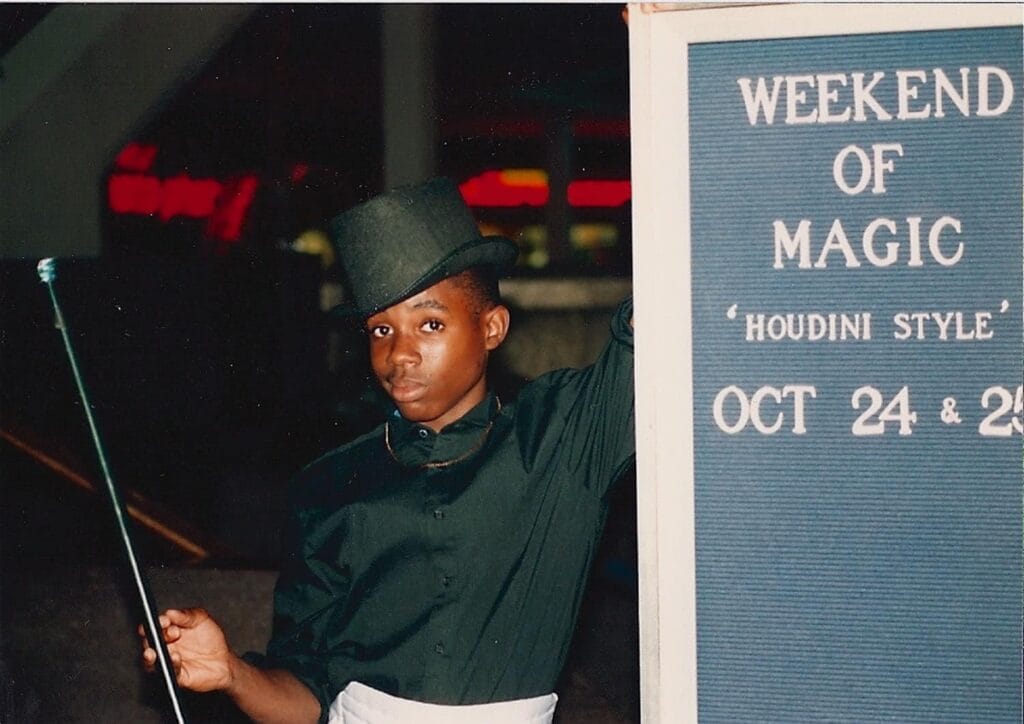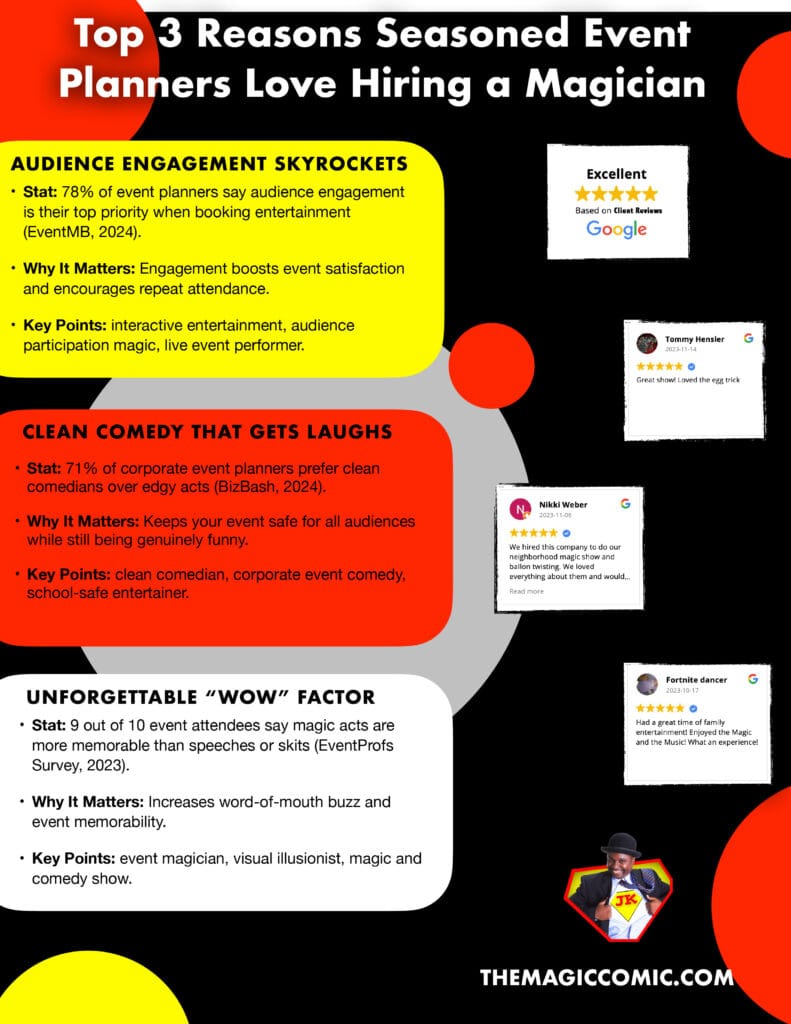When Houdini Died: Why Escape Artists Still Thrill Us on October 31
Table of Contents
ToggleEvery October 31, the world remembers the death of Harry Houdini (October 31, 1926). Wikipedia The “Handcuff King” whose daring escapes—straitjackets, water torture cells, buried alive—not only pushed the boundaries of performance but created an enduring fascination with escape artistry. On Halloween, when the veil between life and death is thin, it’s especially fitting to explore what makes the escape artist so compelling—and how The Magic Comic – Jamahl Keyes carries on that legacy with a wink and a laugh.
✨ Five Reasons People Are Intrigued by Escape Artists
Here are five psychological, historical, and emotional reasons people remain fascinated by escape artistry—and why Houdini’s memory looms large in that fascination.
Houdini built his fame around stunts that might kill him—drowning escapes, being buried alive, suspended in straitjackets.
People are naturally drawn to risk; in performance, the possibility that something could go wrong heightens adrenaline, suspense, and emotional investment.
Escape artistry depends on unknown methods. Audiences know there’s trickery or preparation, but they don’t know whichtricks or how much danger is real. We love trying to solve the puzzle. The allure of the unseen—locks, restraints, submerged tanks—has romance. Houdini famously kept many methods secret.
It takes physical strength, agility, intense training, and mental discipline to pull off escapes. We admire performers who conquer constraints. The idea that a human can overcome chains, water pressure, lack of oxygen, confined spaces—it inspires awe.
Beyond showmanship, escape art taps into deeper human yearnings—to break free: from fears, from restrictions, from death itself. On Halloween, when people think about mortality and the supernatural, escape becomes metaphor. Essays like “The Thrill of Escape Artistry in a Post-Houdini New York” point out that escape acts suggest there’s more to the world than meets the eye.
Large props, dramatic settings (water tanks, straightjackets, chained trunks), build-ups, timers, danger—all contribute to a theatrical, memorable experience. Also, people love stories: the countdown, the viewer who holds their breath, the moment of release. The audience isn’t just watching a magic trick; they are part of an emotional journey.
📊 Some Stats & Cultural Impact Data
Here are a few numbers to show how enduring, popular, and robust this fascination is:
Houdini’s life and career remain well documented; his death on October 31, 1926 is still widely referenced in magic histories. Wikipedia
Escapology is recognized as a distinct branch of magic: escaping from handcuffs, straitjackets, sealed containers, etc. Wikipedia
While exact data on live escape performance (magic & physical stunts) is harder to isolate, related escape-entertainment experiences—like escape rooms—are booming. In the U.S., the number of escape room facilities grew from just a few dozen in 2014 to over 1,900 by late 2023. Room Escape Artist
The average escape room (as a business model) had generated ~$300,000+ in revenue pre-pandemic under certain usage assumptions. xola.com
Public opinion and cultural studies suggest people seek out performances that provide “escape” in a psychological sense—relief from routine, crisis, or fear, especially during times of uncertainty. Escape artistry fulfills both literal escape (chains, boxes) and figurative escape (fear, the mundane).
🎭 How The Magic Comic – Jamahl Keyes Performs Escape Artist Tricks—With Comedy

The Magic Comic – Jamahl Keyes, escape artistry is part spectacle, part storytelling, and heavily spiced with humor. Here’s how we blend the tension of escape with comedic relief—so audiences both hold their breath and laugh.
Building suspense before the punchline
We’ll set up a dramatic scenario—a locked trunk, maybe a gag about “if I don’t get out, I lose my keys / my dignity / my shoes”—and let the tension build. Then, somewhere near the escape, something absurd happens: a comedic mishap, a prop that misbehaves, a bit of audience participation that throws off timing (on purpose).Playing with expectations
Houdini’s escapes were serious, grand, often life-or-death. In contrast, we’ll reference them: “I may not be Houdini, but I don’t want to end up like him… buried alive… in a coffin someone forgot to open.” These wink nods (pun intended) let the audience be in on the joke, to feel the gravity but laugh at the absurdity.Physical comedy + danger illusions
Using close-calls rather than real danger: chains, locks, water props, maybe even straitjackets—but in ways that leverage comedic timing: perhaps a chain rattle, an actor messing up lock-picking, over-dramatic struggle, maybe comedic gasps. The idea is to simulate danger, but in a way that stays entertaining, not terrifying.Audience interaction & surprise
Part of what makes an escape act powerful is uncertainty. We’ll draw on that: a volunteer helps lock a chain, perhaps the audience votes on which challenge the performer must escape from. Then the unexpected: a surprise twist, a comedic escape route, or some humor even in failure (but always recovery).Honoring Houdini while making it present
Since this show is in October, and especially around Halloween / Houdini’s death date, we’ll incorporate elements that pay homage: referencing his famous water torture cell, the buried alive stunts, straitjackets, etc., but reframing them in our own comedic voice. We respect the danger Houdini faced, but in our show, we remind audiences: this is theater, illusion, joy—even when darkness or suspense is present.
Conclusion: The Magic of Escape, Even After Houdini:
On October 31 we remember Houdini, his daring escapes, and ultimately his passing. But his legacy lives on. Escape artistry endures because it appeals to something primal: our fear, our curiosity, our desire to see a seemingly impossible freedom achieved. And when you add comedy—when the performer pulls us up to the edge, then gives us laughter—you get something deep, satisfying, and memorable.
The Magic Comic – Jamahl Keyes, escape artist tricks aren’t just about locks and danger; they’re about the shared gasp, the nervous chuckle, and the triumphant release. That’s why, even nearly a century after Houdini’s death, when someone shows you locked in chains, you lean forward—and you believe.





